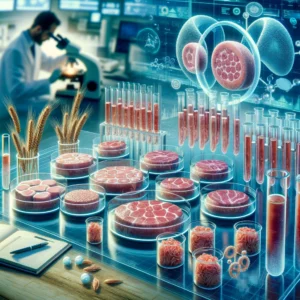A Breakthrough in Lab-Grown Meat Production
As the global population continues to rise, the demand for sustainable and efficient protein sources is more pressing than ever. Lab-grown or cultivated meat, consisting of animal muscle and fat cells grown in laboratory conditions, has been identified as a promising solution. In a groundbreaking development, researchers have discovered a way to use an edible and affordable plant protein, glutenin, a non-allergenic wheat protein, to cultivate these cell cultures effectively.

This innovative approach, detailed in ACS Biomaterials Science & Engineering, demonstrates that glutenin can successfully develop striated muscle layers and flat fat layers. These layers can then be merged to create textures akin to traditional meat. Cultured cells require a base or scaffold for adherence and growth. Plant proteins, particularly glutenin, emerge as ideal candidates for these scaffolds due to their edibility, abundance, and low cost.
Previous studies had already shown glutenin’s potential as a base for cultivating cow skeletal muscle cells. However, for this method to yield a viable meat substitute, it’s crucial for the muscle cells to form aligned fibers, mimicking the texture of real animal tissues. Additionally, integrating fat into this 3D structure is essential to replicate the comprehensive composition of conventional meat products.
Part 2: Creating Textured Meat Alternatives with Plant-Based Films
To harness glutenin’s potential, a team of researchers, including Ya Yao, John Yuen, Jr., Chunmei Li, and David Kaplan, set out to develop plant-based films using this protein. Their goal was to grow textured muscle cells and fatty layers effectively. The team isolated glutenin from wheat gluten, creating films with both flat and ridge-patterned surfaces. Mouse cells, destined to develop into skeletal muscle, were then deposited on these protein bases.
Over two weeks of incubation, cells proliferated on both types of films. While the growth on glutenin-based films wasn’t as robust as that on control films made of gelatin, it was still sufficient. This finding suggests a need for further enhancement in how cells attach to the plant-based film to achieve growth comparable to animal-derived biomaterials.
In a particularly promising development, cells on the patterned film formed long, parallel bundles during the second week, effectively recreating the fiber structure characteristic of animal muscles. Another experiment involved depositing mouse cells, which produce fat tissues, onto flat glutenin films. These cells proliferated and differentiated, producing visible lipid and collagen deposits, essential components of real meat.
The researchers envision layering the cultivated meat and fat on the edible glutenin films to form a 3D meat-like product. Given that the glutenin material base supported the growth of both animal muscle and fat layers with realistic textures, it presents a substantial step towards more authentic cultivated meat products. This breakthrough could pave the way for sustainable, allergy-friendly, and realistic meat alternatives, addressing both environmental concerns and dietary restrictions.